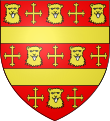
Back Maison de Godwin French Dinastia Godwin Italian Huset Godwin NB Годвинсоны Russian Ґодвіни (рід) Ukrainian
| House of Godwin | |
|---|---|
| Royal and princely house | |
 Attributed arms of Godwin, Earl of Wessex and Harold, King of England based on the Stained-glass in the Great Hall of Winchester Castle. | |
| Parent family | House of Wessex (?) |
| Place of origin | Sussex |
| Founder | Godwin, Earl of Wessex |
| Final ruler | Harold Godwinson (14 October 1066) |
| Seat | |
| Titles | |
| Connected families | |
| Dissolution | 14 October 1066 |
| Cadet branches |
|
The House of Godwin (Old English: Godƿine) was an Anglo-Saxon family who were one of the leading noble families in England during the last fifty years before the Norman Conquest. Its most famous member was Harold Godwinson, King of England for nine months in 1066.
The founder of the family's greatness, Earl Godwin, was raised from comparative obscurity by King Cnut and given the Earldom of Wessex c. 1018–1019. He retained his position during the reigns of Cnut's sons Harold Harefoot and Harthacnut, and consolidated it when King Edward the Confessor conferred earldoms on Sweyn and Harold, Godwin's two eldest sons by his Danish wife Gytha.
The family survived a short-lived exile in Flanders 1051–1052. After Godwin's death in 1053, his sons held the earldoms of Wessex, East Anglia, and later Northumbria; Harold, in particular, became the most powerful man in England, eclipsing the power of the king. When Edward the Confessor died childless in 1066, he was succeeded by Harold Godwinson.
Harold gained a great victory over the Norwegian king Harald Hardrada and his own estranged brother Tostig Godwinson at the Battle of Stamford Bridge. Three weeks later, with his defeat and death at the Battle of Hastings, Anglo-Saxon self-rule came to an end. Later generations of the family were scattered around Northern Europe. Through female lines, the Godwin family are ancestors of royal houses across Europe, including the Grand Princes of Kiev and the modern British royal family.[1][2][3]
Patrilineally, agnates of the House of Godwin have lived in Norway since 1067, where they belonged to the kingdom's greatest aristocratic dynasties. King Olaf III of Norway installed Skule Kongsfostre, a stepson of Earl Tostig, at the Rein estate in Trøndelag (Central Norway), establishing the Rein dynasty. Among his descendants were King Inge II of Norway, Duke Skule Bårdsson, and Queen Margaret Skulesdottir.
Earl Tostig's younger son, Ketil Hook, was given the Torgar estate in Hålogaland (Northern Norway) and married a granddaughter of chieftain Hárek of Tjøtta, establishing the younger Torgar dynasty. Finally, King Harold Godwinson's son Harold Haroldson joined the retinue of King Magnus III of Norway; his descendants may have been the many Godwins who appear in Eastern Norway from the early 13th century.
As earls, that is, quasi-sovereign princes, the family maintained its own hirð (pre-nobility retinue), including housecarls. In contemporary sources, including Vita Ædwardi Regis, the Godwins are described as dux (duke) and princeps (prince). The earls under King Edward the Confessor 'enjoyed viceregal powers' in their respective jurisdictions, according to Ian W. Walker (1997). Modern historians have characterised Godwin and his family as among the most famous in English history (David Bates) and one of the greatest noble houses in England in the first half of the 11th century (Frank Barlow).
- ^ Mason 2004, p. 201.
- ^ Haastrup & Lind 2013, p. 394.
- ^ Freeman 1871, pp. 159–160.